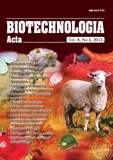ISSN 2410-776X (Online),
ISSN 2410-7751 (Print)

Biotechnologia Acta V. 8, No 3, 2015
https://doi.org/10.15407/biotech8.03.110
Р. 110-115, Bibliography 5, Ukrainian
Universal Decimal Classification: 664.0 637.52
DECREASING OF SODIUM NITRITE CONTENT IN COOKED SAUSAGES USING DENITRIFYING MICROORGANISMS
Bal-Prylypko L. V., Leonova B. I.
National University of Life and Environmental Sciences of Ukraine, Kyiv
The purpose of this work was to study reduction of sodium nitrite in cooked sausages by adding of the optimized amount of denitrifying microorganisms to the bacterial preparation maintaining quality characteristics of the product. To develop biotechnology of boiled sausages «Naturel» we selected bacterial preparation based on nitrite-reducing strains of Staphylococcus carnosus and S. carnosus ssp.utilis. It was used generally accepted and special methods. The content of total pigments and nitrozopigments was determined by a method based on the extraction of meat pigments by aqueous acetone; color stability of final products was evaluated as the difference in optical density of nitroso pigment extracts before and after exposure (40 min) of the sample under the light source; analytical processing of the experimental data was carried out using modern software; quantitative evaluation of color characteristics was performed in the RGB using a multifunctional device Epson Stylus TX400. Mathematical modeling was carried out on the basis of full factorial experiment such as 22, the optimization was performed by Box–Wilson. According to the study, using of the bacterial preparation based on nitrite-reducing strains of Staphylococcus carnosus and S. carnosus ssp. utilis in biotechnology of boiled sausages «Naturel» has a positive effect on the formation of the complex of required color characteristics of final products (for prototypes of sausages the index redness was 1. 61 times higher compared to the control). Degradation of sodium nitrite and formation of nitroso pigments were intensified that improved the stability of color during the storage (the index of color fastness of experimental cooked sausages was higher by 19%). The results of performed investigations illustrate the possibility of production of cooked sausages with a minimized content of synthetic food additives and ingredients.
Key words: boiled sausage, sodium nitrite, denitrifying microorganisms.
© Palladin Institute of Biochemistry of the National Academy of Sciences of Ukraine, 2015
References
1. Mashenceva N. G., Horol’skij V. V. Functional starter cultures in the meat industry. Мoskva: DeLi print. 2008, 336 p. (In Russian).
2. De Vuyst L., Leroy F. Bacteriocins from Lactic Acid Bacteria: Production, Purification, and Food Applications Luc. Mol. Microbiol. Biotechnol. 2007, V. 13, Р. 194–199.
3. Laptev I. A,. Mashenceva N. G., Horol’skij V. V., Semenysheva A. I. i dr. High quality meat products without residual sodium nitrite. Myasnaya industriya. 2007, N 12, P. 25–28. (In Russian).
4. Nefedova N. V., Artamonova M. P., Pomikov A. N. Study of the functional properties of sausages with starter cultures. Myasnaya industriya. 2003, N 11, P. 48–49. (In Russian).
5. Hamagaeva I. S., Hamaganova I. V., Darbakova N. V., Zambalova N. A. Effect of propionic acid bacteria culture fluid on the formation of the quality of cooked sausages. Vse o myase. 2011, N 5, P. 37–39. (In Russian).

